Report: Impact of Communication on Organizational Performance Analysis
VerifiedAdded on 2020/03/16
|7
|2049
|62
Report
AI Summary
This report investigates the impact of communication on organizational performance, employing a mixed-methods research design, combining both qualitative and quantitative approaches. The research outlines the methodology, including data collection through primary and secondary sources, with a focus on questionnaires and analysis of internet sources. The inductive research philosophy guides the study, progressing from specific observations to general theories. The report details a sampling technique, random sampling, to ensure reliable data analysis and a timeframe that includes planning, implementation, data collection, and analysis. Ethical considerations are addressed, ensuring data reliability and confidentiality. Limitations such as limited resources and time are acknowledged. The study concludes with a discussion of the impact of communication, providing recommendations based on the research findings.
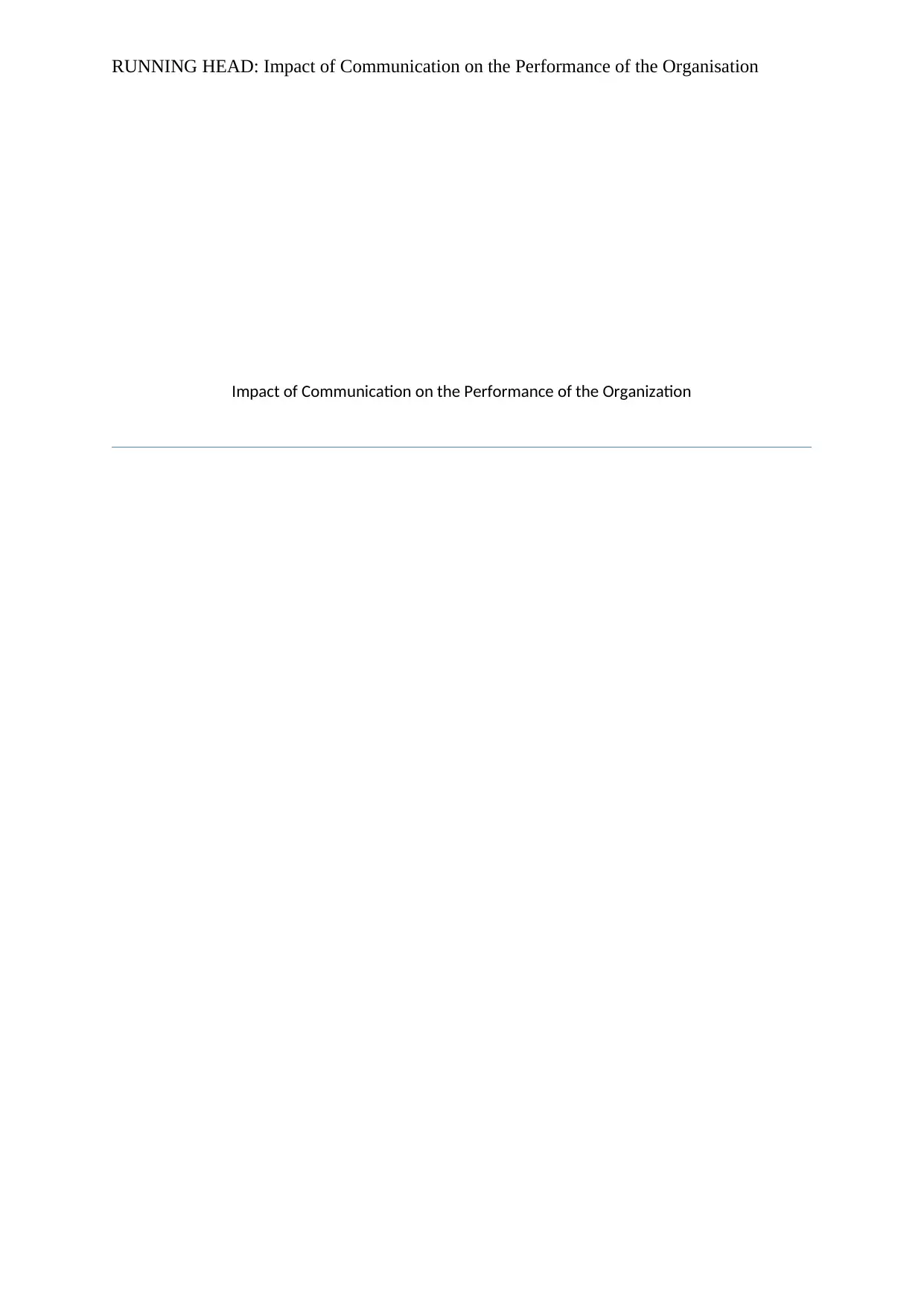
RUNNING HEAD: Impact of Communication on the Performance of the Organisation
Impact of Communication on the Performance of the Organization
Impact of Communication on the Performance of the Organization
Paraphrase This Document
Need a fresh take? Get an instant paraphrase of this document with our AI Paraphraser
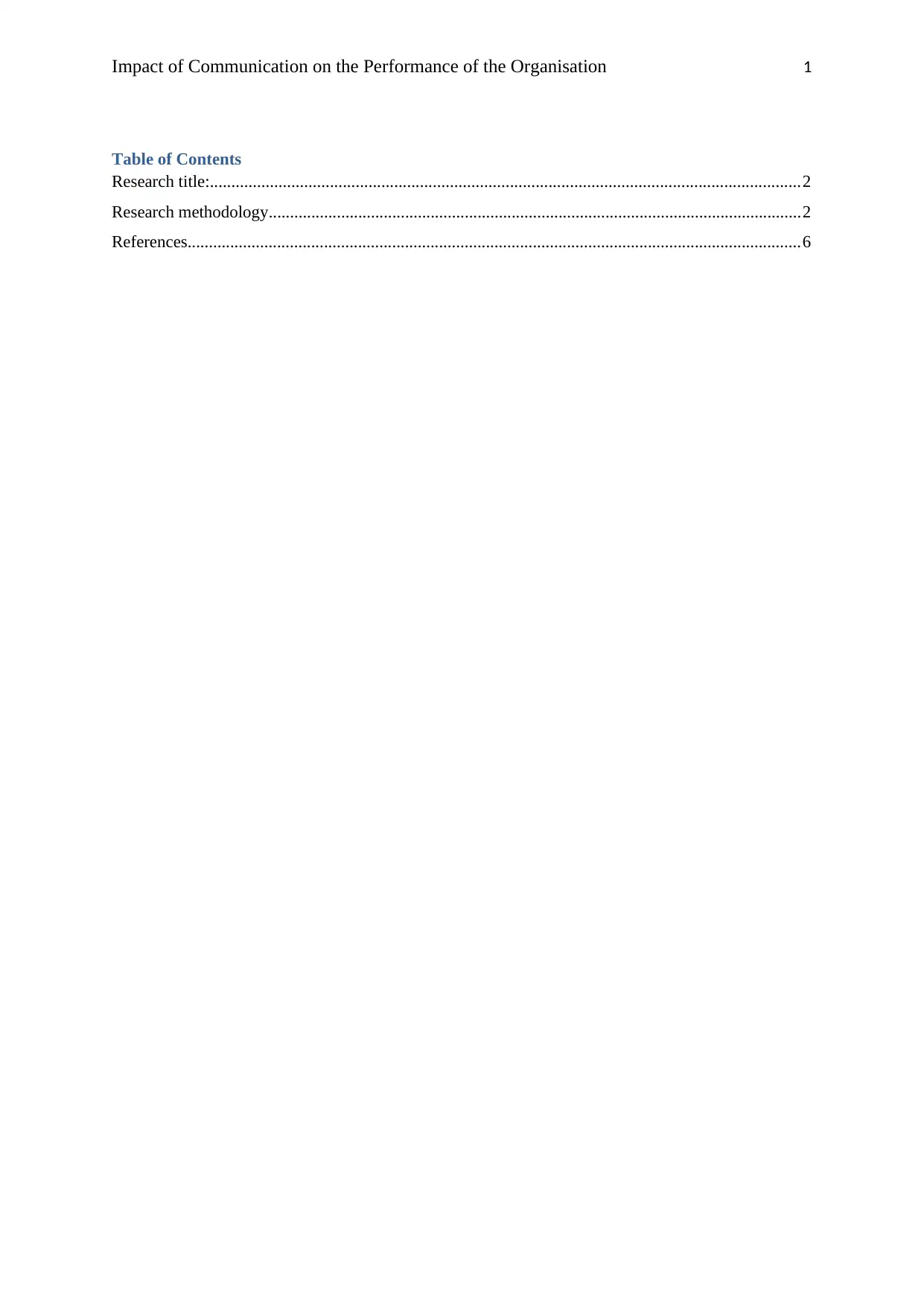
Impact of Communication on the Performance of the Organisation 1
Table of Contents
Research title:..........................................................................................................................................2
Research methodology.............................................................................................................................2
References................................................................................................................................................6
Table of Contents
Research title:..........................................................................................................................................2
Research methodology.............................................................................................................................2
References................................................................................................................................................6
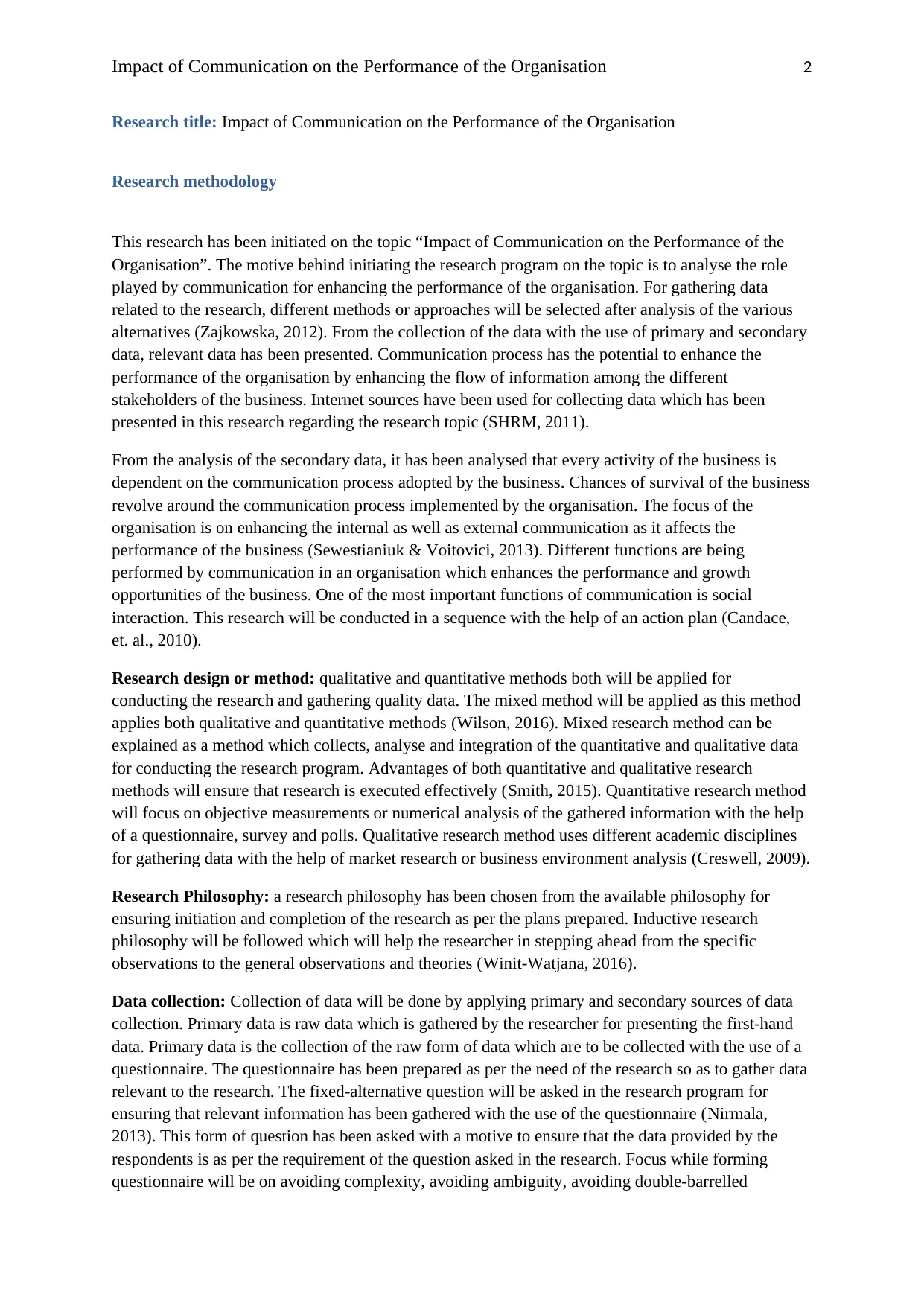
Impact of Communication on the Performance of the Organisation 2
Research title: Impact of Communication on the Performance of the Organisation
Research methodology
This research has been initiated on the topic “Impact of Communication on the Performance of the
Organisation”. The motive behind initiating the research program on the topic is to analyse the role
played by communication for enhancing the performance of the organisation. For gathering data
related to the research, different methods or approaches will be selected after analysis of the various
alternatives (Zajkowska, 2012). From the collection of the data with the use of primary and secondary
data, relevant data has been presented. Communication process has the potential to enhance the
performance of the organisation by enhancing the flow of information among the different
stakeholders of the business. Internet sources have been used for collecting data which has been
presented in this research regarding the research topic (SHRM, 2011).
From the analysis of the secondary data, it has been analysed that every activity of the business is
dependent on the communication process adopted by the business. Chances of survival of the business
revolve around the communication process implemented by the organisation. The focus of the
organisation is on enhancing the internal as well as external communication as it affects the
performance of the business (Sewestianiuk & Voitovici, 2013). Different functions are being
performed by communication in an organisation which enhances the performance and growth
opportunities of the business. One of the most important functions of communication is social
interaction. This research will be conducted in a sequence with the help of an action plan (Candace,
et. al., 2010).
Research design or method: qualitative and quantitative methods both will be applied for
conducting the research and gathering quality data. The mixed method will be applied as this method
applies both qualitative and quantitative methods (Wilson, 2016). Mixed research method can be
explained as a method which collects, analyse and integration of the quantitative and qualitative data
for conducting the research program. Advantages of both quantitative and qualitative research
methods will ensure that research is executed effectively (Smith, 2015). Quantitative research method
will focus on objective measurements or numerical analysis of the gathered information with the help
of a questionnaire, survey and polls. Qualitative research method uses different academic disciplines
for gathering data with the help of market research or business environment analysis (Creswell, 2009).
Research Philosophy: a research philosophy has been chosen from the available philosophy for
ensuring initiation and completion of the research as per the plans prepared. Inductive research
philosophy will be followed which will help the researcher in stepping ahead from the specific
observations to the general observations and theories (Winit-Watjana, 2016).
Data collection: Collection of data will be done by applying primary and secondary sources of data
collection. Primary data is raw data which is gathered by the researcher for presenting the first-hand
data. Primary data is the collection of the raw form of data which are to be collected with the use of a
questionnaire. The questionnaire has been prepared as per the need of the research so as to gather data
relevant to the research. The fixed-alternative question will be asked in the research program for
ensuring that relevant information has been gathered with the use of the questionnaire (Nirmala,
2013). This form of question has been asked with a motive to ensure that the data provided by the
respondents is as per the requirement of the question asked in the research. Focus while forming
questionnaire will be on avoiding complexity, avoiding ambiguity, avoiding double-barrelled
Research title: Impact of Communication on the Performance of the Organisation
Research methodology
This research has been initiated on the topic “Impact of Communication on the Performance of the
Organisation”. The motive behind initiating the research program on the topic is to analyse the role
played by communication for enhancing the performance of the organisation. For gathering data
related to the research, different methods or approaches will be selected after analysis of the various
alternatives (Zajkowska, 2012). From the collection of the data with the use of primary and secondary
data, relevant data has been presented. Communication process has the potential to enhance the
performance of the organisation by enhancing the flow of information among the different
stakeholders of the business. Internet sources have been used for collecting data which has been
presented in this research regarding the research topic (SHRM, 2011).
From the analysis of the secondary data, it has been analysed that every activity of the business is
dependent on the communication process adopted by the business. Chances of survival of the business
revolve around the communication process implemented by the organisation. The focus of the
organisation is on enhancing the internal as well as external communication as it affects the
performance of the business (Sewestianiuk & Voitovici, 2013). Different functions are being
performed by communication in an organisation which enhances the performance and growth
opportunities of the business. One of the most important functions of communication is social
interaction. This research will be conducted in a sequence with the help of an action plan (Candace,
et. al., 2010).
Research design or method: qualitative and quantitative methods both will be applied for
conducting the research and gathering quality data. The mixed method will be applied as this method
applies both qualitative and quantitative methods (Wilson, 2016). Mixed research method can be
explained as a method which collects, analyse and integration of the quantitative and qualitative data
for conducting the research program. Advantages of both quantitative and qualitative research
methods will ensure that research is executed effectively (Smith, 2015). Quantitative research method
will focus on objective measurements or numerical analysis of the gathered information with the help
of a questionnaire, survey and polls. Qualitative research method uses different academic disciplines
for gathering data with the help of market research or business environment analysis (Creswell, 2009).
Research Philosophy: a research philosophy has been chosen from the available philosophy for
ensuring initiation and completion of the research as per the plans prepared. Inductive research
philosophy will be followed which will help the researcher in stepping ahead from the specific
observations to the general observations and theories (Winit-Watjana, 2016).
Data collection: Collection of data will be done by applying primary and secondary sources of data
collection. Primary data is raw data which is gathered by the researcher for presenting the first-hand
data. Primary data is the collection of the raw form of data which are to be collected with the use of a
questionnaire. The questionnaire has been prepared as per the need of the research so as to gather data
relevant to the research. The fixed-alternative question will be asked in the research program for
ensuring that relevant information has been gathered with the use of the questionnaire (Nirmala,
2013). This form of question has been asked with a motive to ensure that the data provided by the
respondents is as per the requirement of the question asked in the research. Focus while forming
questionnaire will be on avoiding complexity, avoiding ambiguity, avoiding double-barrelled
⊘ This is a preview!⊘
Do you want full access?
Subscribe today to unlock all pages.

Trusted by 1+ million students worldwide
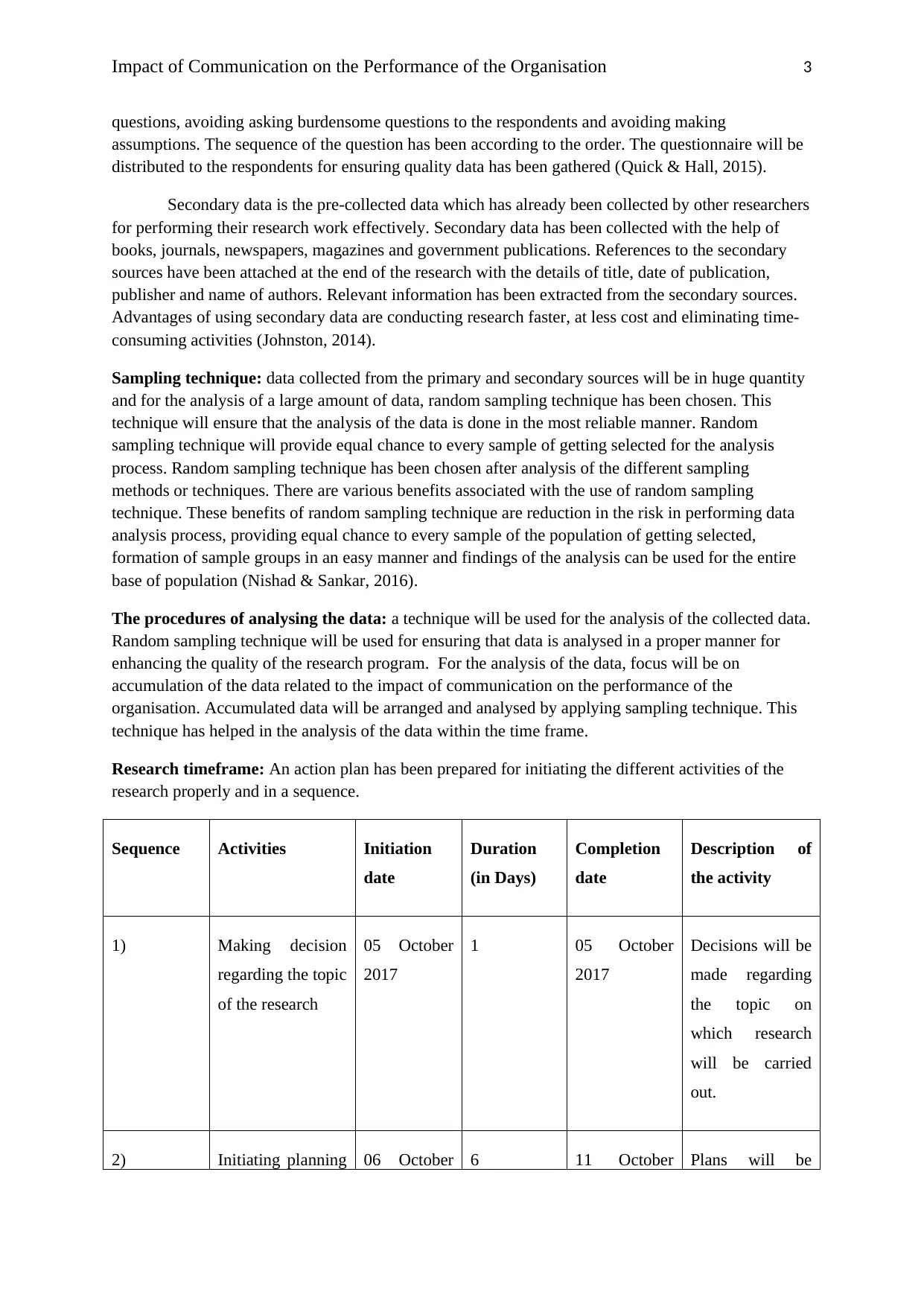
Impact of Communication on the Performance of the Organisation 3
questions, avoiding asking burdensome questions to the respondents and avoiding making
assumptions. The sequence of the question has been according to the order. The questionnaire will be
distributed to the respondents for ensuring quality data has been gathered (Quick & Hall, 2015).
Secondary data is the pre-collected data which has already been collected by other researchers
for performing their research work effectively. Secondary data has been collected with the help of
books, journals, newspapers, magazines and government publications. References to the secondary
sources have been attached at the end of the research with the details of title, date of publication,
publisher and name of authors. Relevant information has been extracted from the secondary sources.
Advantages of using secondary data are conducting research faster, at less cost and eliminating time-
consuming activities (Johnston, 2014).
Sampling technique: data collected from the primary and secondary sources will be in huge quantity
and for the analysis of a large amount of data, random sampling technique has been chosen. This
technique will ensure that the analysis of the data is done in the most reliable manner. Random
sampling technique will provide equal chance to every sample of getting selected for the analysis
process. Random sampling technique has been chosen after analysis of the different sampling
methods or techniques. There are various benefits associated with the use of random sampling
technique. These benefits of random sampling technique are reduction in the risk in performing data
analysis process, providing equal chance to every sample of the population of getting selected,
formation of sample groups in an easy manner and findings of the analysis can be used for the entire
base of population (Nishad & Sankar, 2016).
The procedures of analysing the data: a technique will be used for the analysis of the collected data.
Random sampling technique will be used for ensuring that data is analysed in a proper manner for
enhancing the quality of the research program. For the analysis of the data, focus will be on
accumulation of the data related to the impact of communication on the performance of the
organisation. Accumulated data will be arranged and analysed by applying sampling technique. This
technique has helped in the analysis of the data within the time frame.
Research timeframe: An action plan has been prepared for initiating the different activities of the
research properly and in a sequence.
Sequence Activities Initiation
date
Duration
(in Days)
Completion
date
Description of
the activity
1) Making decision
regarding the topic
of the research
05 October
2017
1 05 October
2017
Decisions will be
made regarding
the topic on
which research
will be carried
out.
2) Initiating planning 06 October 6 11 October Plans will be
questions, avoiding asking burdensome questions to the respondents and avoiding making
assumptions. The sequence of the question has been according to the order. The questionnaire will be
distributed to the respondents for ensuring quality data has been gathered (Quick & Hall, 2015).
Secondary data is the pre-collected data which has already been collected by other researchers
for performing their research work effectively. Secondary data has been collected with the help of
books, journals, newspapers, magazines and government publications. References to the secondary
sources have been attached at the end of the research with the details of title, date of publication,
publisher and name of authors. Relevant information has been extracted from the secondary sources.
Advantages of using secondary data are conducting research faster, at less cost and eliminating time-
consuming activities (Johnston, 2014).
Sampling technique: data collected from the primary and secondary sources will be in huge quantity
and for the analysis of a large amount of data, random sampling technique has been chosen. This
technique will ensure that the analysis of the data is done in the most reliable manner. Random
sampling technique will provide equal chance to every sample of getting selected for the analysis
process. Random sampling technique has been chosen after analysis of the different sampling
methods or techniques. There are various benefits associated with the use of random sampling
technique. These benefits of random sampling technique are reduction in the risk in performing data
analysis process, providing equal chance to every sample of the population of getting selected,
formation of sample groups in an easy manner and findings of the analysis can be used for the entire
base of population (Nishad & Sankar, 2016).
The procedures of analysing the data: a technique will be used for the analysis of the collected data.
Random sampling technique will be used for ensuring that data is analysed in a proper manner for
enhancing the quality of the research program. For the analysis of the data, focus will be on
accumulation of the data related to the impact of communication on the performance of the
organisation. Accumulated data will be arranged and analysed by applying sampling technique. This
technique has helped in the analysis of the data within the time frame.
Research timeframe: An action plan has been prepared for initiating the different activities of the
research properly and in a sequence.
Sequence Activities Initiation
date
Duration
(in Days)
Completion
date
Description of
the activity
1) Making decision
regarding the topic
of the research
05 October
2017
1 05 October
2017
Decisions will be
made regarding
the topic on
which research
will be carried
out.
2) Initiating planning 06 October 6 11 October Plans will be
Paraphrase This Document
Need a fresh take? Get an instant paraphrase of this document with our AI Paraphraser
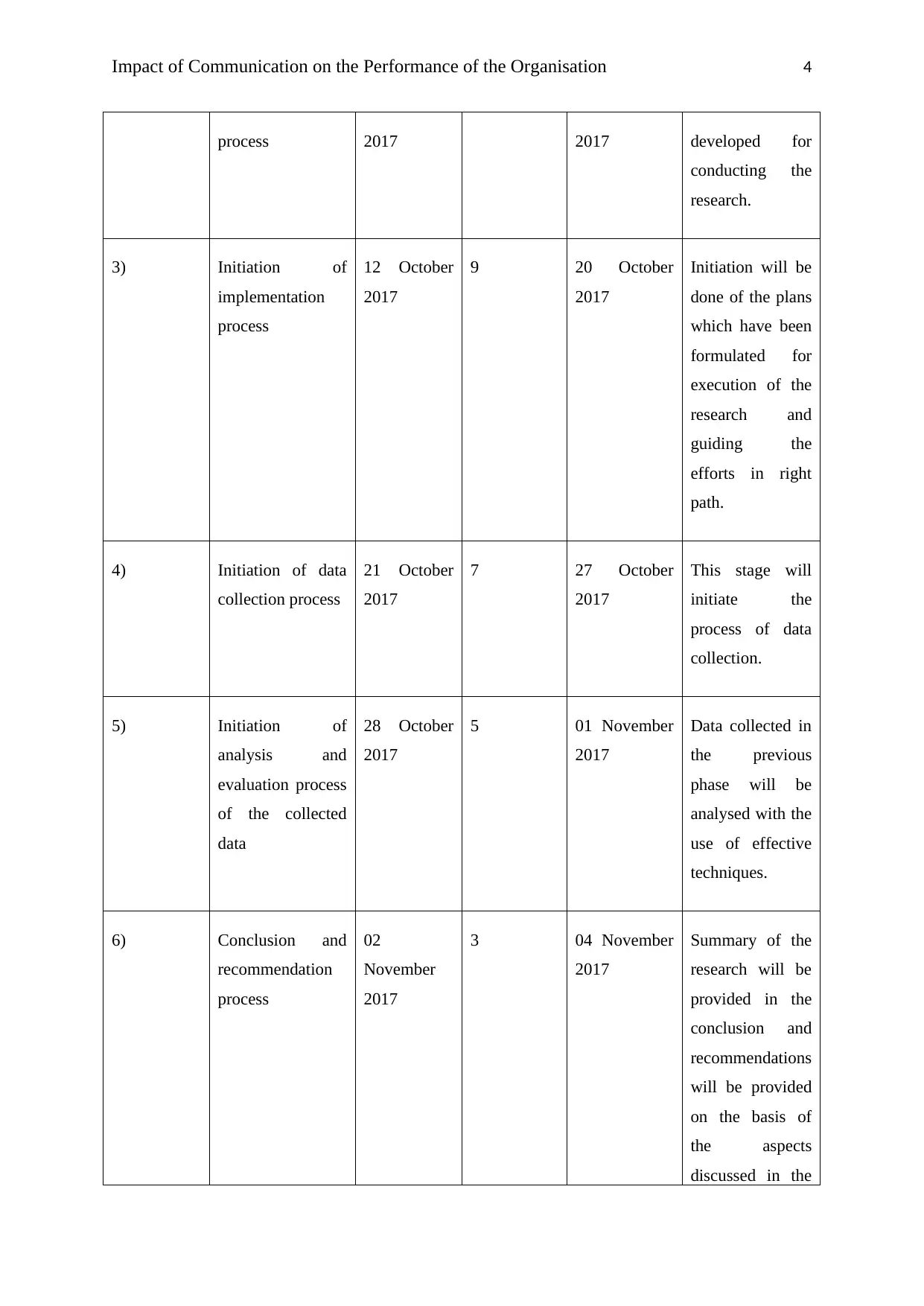
Impact of Communication on the Performance of the Organisation 4
process 2017 2017 developed for
conducting the
research.
3) Initiation of
implementation
process
12 October
2017
9 20 October
2017
Initiation will be
done of the plans
which have been
formulated for
execution of the
research and
guiding the
efforts in right
path.
4) Initiation of data
collection process
21 October
2017
7 27 October
2017
This stage will
initiate the
process of data
collection.
5) Initiation of
analysis and
evaluation process
of the collected
data
28 October
2017
5 01 November
2017
Data collected in
the previous
phase will be
analysed with the
use of effective
techniques.
6) Conclusion and
recommendation
process
02
November
2017
3 04 November
2017
Summary of the
research will be
provided in the
conclusion and
recommendations
will be provided
on the basis of
the aspects
discussed in the
process 2017 2017 developed for
conducting the
research.
3) Initiation of
implementation
process
12 October
2017
9 20 October
2017
Initiation will be
done of the plans
which have been
formulated for
execution of the
research and
guiding the
efforts in right
path.
4) Initiation of data
collection process
21 October
2017
7 27 October
2017
This stage will
initiate the
process of data
collection.
5) Initiation of
analysis and
evaluation process
of the collected
data
28 October
2017
5 01 November
2017
Data collected in
the previous
phase will be
analysed with the
use of effective
techniques.
6) Conclusion and
recommendation
process
02
November
2017
3 04 November
2017
Summary of the
research will be
provided in the
conclusion and
recommendations
will be provided
on the basis of
the aspects
discussed in the
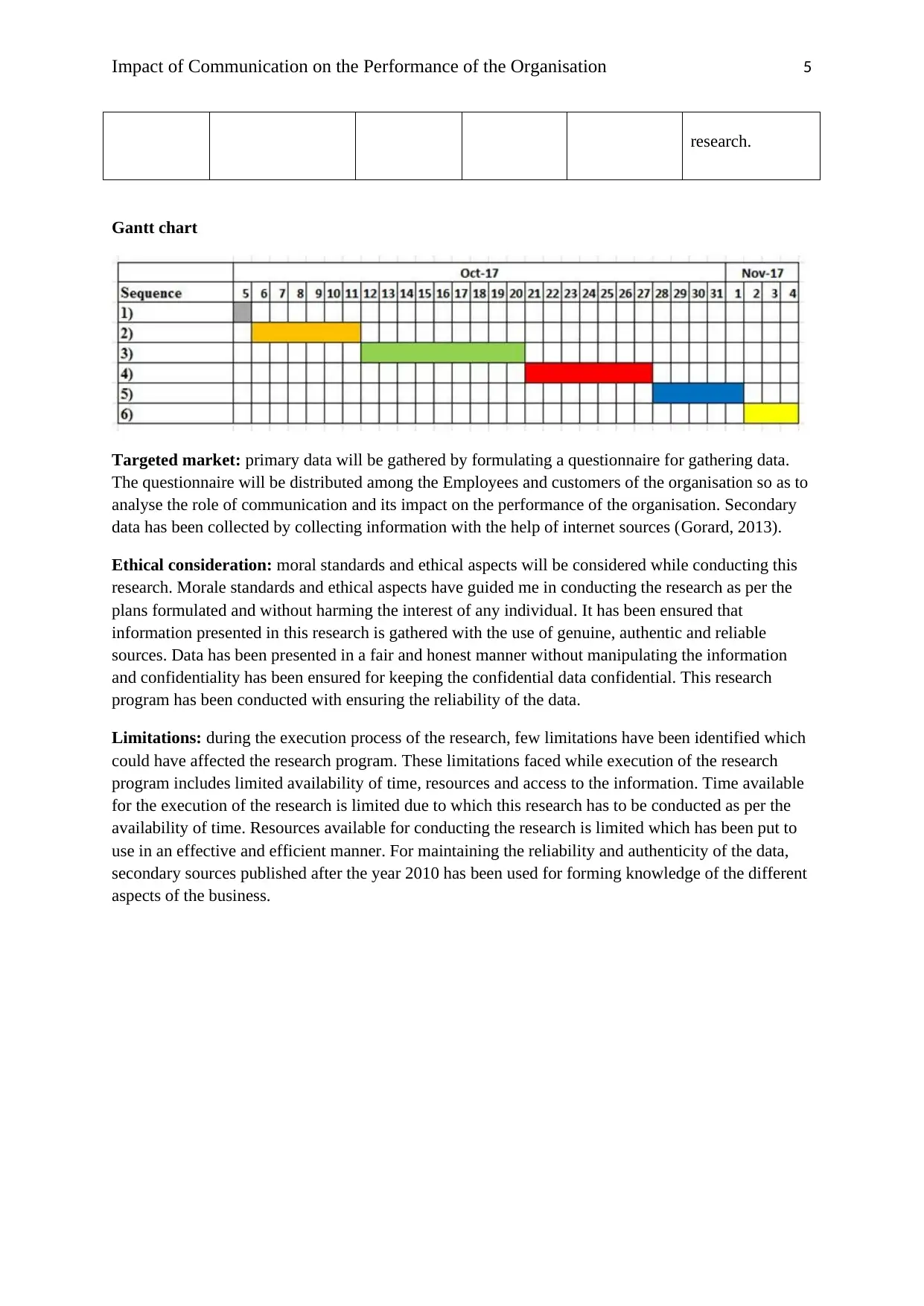
Impact of Communication on the Performance of the Organisation 5
research.
Gantt chart
Targeted market: primary data will be gathered by formulating a questionnaire for gathering data.
The questionnaire will be distributed among the Employees and customers of the organisation so as to
analyse the role of communication and its impact on the performance of the organisation. Secondary
data has been collected by collecting information with the help of internet sources (Gorard, 2013).
Ethical consideration: moral standards and ethical aspects will be considered while conducting this
research. Morale standards and ethical aspects have guided me in conducting the research as per the
plans formulated and without harming the interest of any individual. It has been ensured that
information presented in this research is gathered with the use of genuine, authentic and reliable
sources. Data has been presented in a fair and honest manner without manipulating the information
and confidentiality has been ensured for keeping the confidential data confidential. This research
program has been conducted with ensuring the reliability of the data.
Limitations: during the execution process of the research, few limitations have been identified which
could have affected the research program. These limitations faced while execution of the research
program includes limited availability of time, resources and access to the information. Time available
for the execution of the research is limited due to which this research has to be conducted as per the
availability of time. Resources available for conducting the research is limited which has been put to
use in an effective and efficient manner. For maintaining the reliability and authenticity of the data,
secondary sources published after the year 2010 has been used for forming knowledge of the different
aspects of the business.
research.
Gantt chart
Targeted market: primary data will be gathered by formulating a questionnaire for gathering data.
The questionnaire will be distributed among the Employees and customers of the organisation so as to
analyse the role of communication and its impact on the performance of the organisation. Secondary
data has been collected by collecting information with the help of internet sources (Gorard, 2013).
Ethical consideration: moral standards and ethical aspects will be considered while conducting this
research. Morale standards and ethical aspects have guided me in conducting the research as per the
plans formulated and without harming the interest of any individual. It has been ensured that
information presented in this research is gathered with the use of genuine, authentic and reliable
sources. Data has been presented in a fair and honest manner without manipulating the information
and confidentiality has been ensured for keeping the confidential data confidential. This research
program has been conducted with ensuring the reliability of the data.
Limitations: during the execution process of the research, few limitations have been identified which
could have affected the research program. These limitations faced while execution of the research
program includes limited availability of time, resources and access to the information. Time available
for the execution of the research is limited due to which this research has to be conducted as per the
availability of time. Resources available for conducting the research is limited which has been put to
use in an effective and efficient manner. For maintaining the reliability and authenticity of the data,
secondary sources published after the year 2010 has been used for forming knowledge of the different
aspects of the business.
⊘ This is a preview!⊘
Do you want full access?
Subscribe today to unlock all pages.

Trusted by 1+ million students worldwide
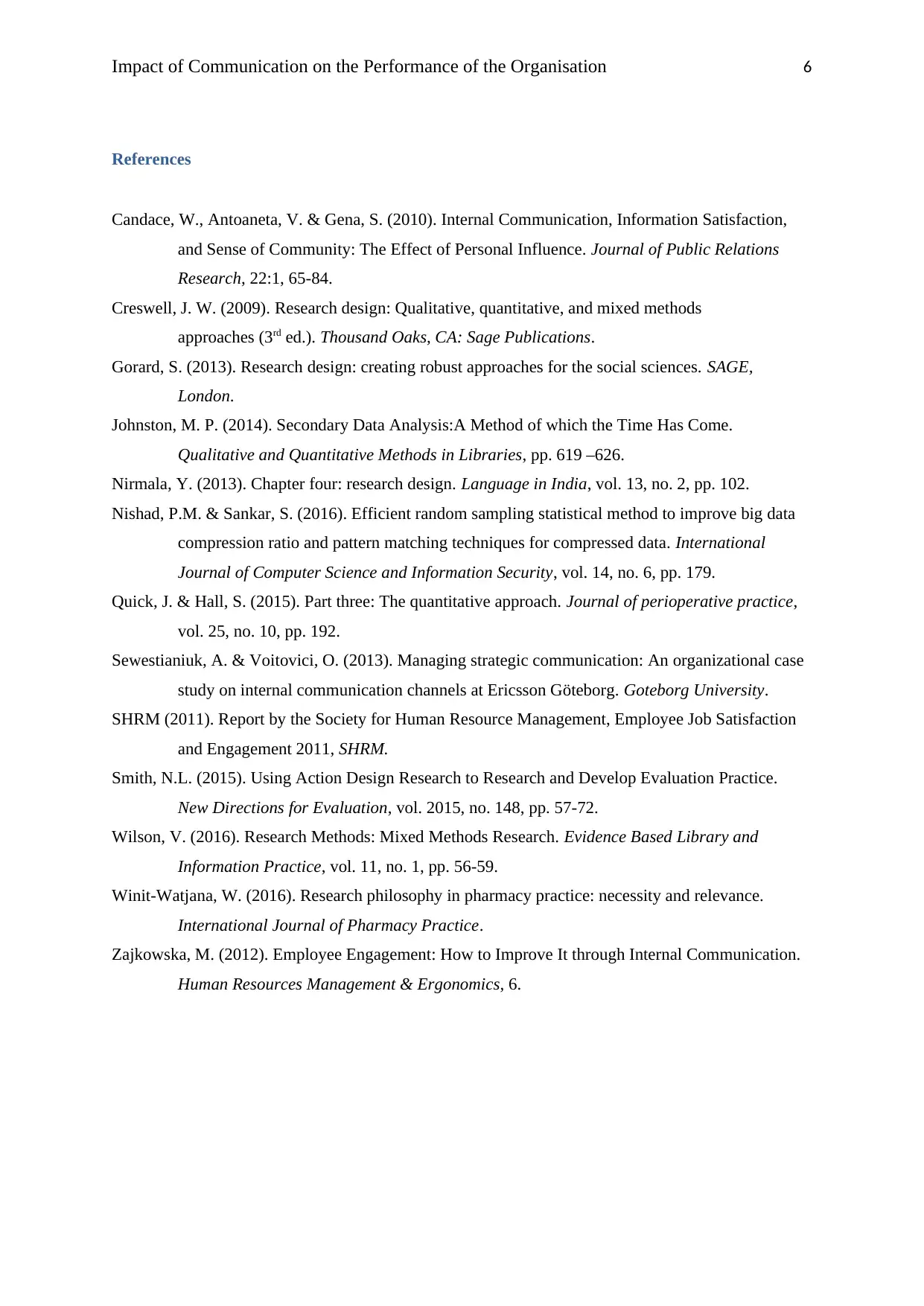
Impact of Communication on the Performance of the Organisation 6
References
Candace, W., Antoaneta, V. & Gena, S. (2010). Internal Communication, Information Satisfaction,
and Sense of Community: The Effect of Personal Influence. Journal of Public Relations
Research, 22:1, 65-84.
Creswell, J. W. (2009). Research design: Qualitative, quantitative, and mixed methods
approaches (3rd ed.). Thousand Oaks, CA: Sage Publications.
Gorard, S. (2013). Research design: creating robust approaches for the social sciences. SAGE,
London.
Johnston, M. P. (2014). Secondary Data Analysis:A Method of which the Time Has Come.
Qualitative and Quantitative Methods in Libraries, pp. 619 –626.
Nirmala, Y. (2013). Chapter four: research design. Language in India, vol. 13, no. 2, pp. 102.
Nishad, P.M. & Sankar, S. (2016). Efficient random sampling statistical method to improve big data
compression ratio and pattern matching techniques for compressed data. International
Journal of Computer Science and Information Security, vol. 14, no. 6, pp. 179.
Quick, J. & Hall, S. (2015). Part three: The quantitative approach. Journal of perioperative practice,
vol. 25, no. 10, pp. 192.
Sewestianiuk, A. & Voitovici, O. (2013). Managing strategic communication: An organizational case
study on internal communication channels at Ericsson Göteborg. Goteborg University.
SHRM (2011). Report by the Society for Human Resource Management, Employee Job Satisfaction
and Engagement 2011, SHRM.
Smith, N.L. (2015). Using Action Design Research to Research and Develop Evaluation Practice.
New Directions for Evaluation, vol. 2015, no. 148, pp. 57-72.
Wilson, V. (2016). Research Methods: Mixed Methods Research. Evidence Based Library and
Information Practice, vol. 11, no. 1, pp. 56-59.
Winit-Watjana, W. (2016). Research philosophy in pharmacy practice: necessity and relevance.
International Journal of Pharmacy Practice.
Zajkowska, M. (2012). Employee Engagement: How to Improve It through Internal Communication.
Human Resources Management & Ergonomics, 6.
References
Candace, W., Antoaneta, V. & Gena, S. (2010). Internal Communication, Information Satisfaction,
and Sense of Community: The Effect of Personal Influence. Journal of Public Relations
Research, 22:1, 65-84.
Creswell, J. W. (2009). Research design: Qualitative, quantitative, and mixed methods
approaches (3rd ed.). Thousand Oaks, CA: Sage Publications.
Gorard, S. (2013). Research design: creating robust approaches for the social sciences. SAGE,
London.
Johnston, M. P. (2014). Secondary Data Analysis:A Method of which the Time Has Come.
Qualitative and Quantitative Methods in Libraries, pp. 619 –626.
Nirmala, Y. (2013). Chapter four: research design. Language in India, vol. 13, no. 2, pp. 102.
Nishad, P.M. & Sankar, S. (2016). Efficient random sampling statistical method to improve big data
compression ratio and pattern matching techniques for compressed data. International
Journal of Computer Science and Information Security, vol. 14, no. 6, pp. 179.
Quick, J. & Hall, S. (2015). Part three: The quantitative approach. Journal of perioperative practice,
vol. 25, no. 10, pp. 192.
Sewestianiuk, A. & Voitovici, O. (2013). Managing strategic communication: An organizational case
study on internal communication channels at Ericsson Göteborg. Goteborg University.
SHRM (2011). Report by the Society for Human Resource Management, Employee Job Satisfaction
and Engagement 2011, SHRM.
Smith, N.L. (2015). Using Action Design Research to Research and Develop Evaluation Practice.
New Directions for Evaluation, vol. 2015, no. 148, pp. 57-72.
Wilson, V. (2016). Research Methods: Mixed Methods Research. Evidence Based Library and
Information Practice, vol. 11, no. 1, pp. 56-59.
Winit-Watjana, W. (2016). Research philosophy in pharmacy practice: necessity and relevance.
International Journal of Pharmacy Practice.
Zajkowska, M. (2012). Employee Engagement: How to Improve It through Internal Communication.
Human Resources Management & Ergonomics, 6.
1 out of 7
Related Documents
Your All-in-One AI-Powered Toolkit for Academic Success.
+13062052269
info@desklib.com
Available 24*7 on WhatsApp / Email
![[object Object]](/_next/static/media/star-bottom.7253800d.svg)
Unlock your academic potential
Copyright © 2020–2025 A2Z Services. All Rights Reserved. Developed and managed by ZUCOL.





